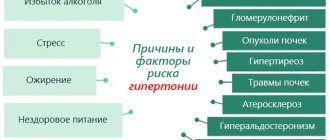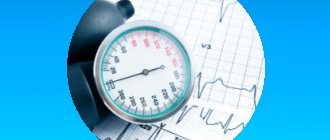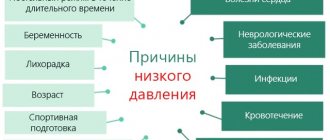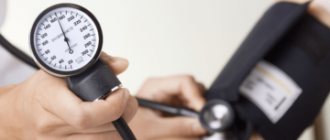Blood pressure is a value that shows how hard the blood presses on the walls of blood vessels. It is an important indicator of the state of the human cardiovascular system.
It happens that, under the influence of certain factors, a pressure reading of 100 to 100 appears on the tonometer, which plunges people into a state of panic.
Is this kind of blood pressure dangerous, and what to do in this case - further in the article.
What does 100 x 100 pressure mean?
The normal pressure is considered to be 120/80. The difference in ratios should be no more than 30-40 mmHg. Art.
However, even in completely healthy people, these indicators can change depending on certain conditions (physical activity, emotional outbursts, fatigue).
When evaluating the measurements taken, it is necessary to pay attention to the value of the upper and lower blood pressure indicators.
Systolic is the upper blood pressure in the vessels at the moment of maximum contraction of the heart.
Diastolic is the lower blood pressure in the arteries when the heart muscle relaxes.
A decrease in the parameters of the upper value to 100 mm and an increase in the lower value to the same figure indicates isolated diastolic hypertension and requires close attention to this problem.
How to normalize blood pressure
Usually doctors do not prescribe drug treatment right away, but try to make do with physiological changes in a person’s life. The patient is recommended to follow a diet with the exclusion or limitation of the amount of table salt, smoked, over-salted and spicy foods. You should also avoid fatty foods to reduce blood cholesterol levels and prevent the development and complications of atherosclerosis.
Regular physical activity is recommended for hypertensive patients, but not too intense, so as not to provoke a crisis of the disease. You can do swimming, yoga, jogging, or just take a daily walk in the fresh air. At the same time, you need to limit your caffeine intake - it is found in tea, coffee, and energy drinks. If the patient is overweight, you need to consult a nutritionist and try to reduce it, since obesity is considered the main concomitant of hypertension.
An important point is the prevention of stressful and conflict situations; it is not for nothing that doctors and people themselves say that all diseases are caused by nerves. During times of stress, the level of adrenaline in a person’s blood increases, which causes vasoconstriction and blood pressure to rise. If the cause of hypertension lies in psychosomatics, you can contact a psychologist or psychotherapist to find the root of the problem and eliminate it.
If drug treatment is necessary, the following is prescribed:
Drops for hypertension
- Diuretics – Veroshpiron, Furosemide, Hypothiazide, Triamterene. They are part of the complex therapy of hypertension, help reduce blood pressure, eliminate edema and normalize heart function.
- Alpha adrenergic blockers – Terazosin, Prazosin. Drugs in this group are well tolerated by patients and also help reduce elevated blood pressure.
- Beta blockers - Bisoprolol, Nadolol, Atenolol, Metoprolol. These drugs act on the nerve centers that control the functioning of the heart muscle, thereby reducing the heart rate. It operates in economical mode, the pressure drops.
- ACE inhibitors – Captopril, Enalapril, Fozinopril. After taking drugs of this group, the production of the hormonal substance angiotensin, which helps to increase blood pressure, is blocked.
- Calcium antagonists - Verapamil, Plendil, Nifedipine. Also used in the complex fight against arterial hypertension, they help expand narrowed capillaries and normalize tonometer readings.
No ads 3
The main problem that arises in the treatment of such pathologies is considered to be the simultaneous decrease in both upper and lower pressure values as a result of taking antihypertensive drugs. Therefore, doctors practice prescribing several medications at the same time in order to maintain systole and diastole within acceptable limits.
If a patient has a problem with blood pressure due to nervous overload and stress, he is advised to take sedatives and herbs. These are tinctures of valerian, motherwort, evasive peony, drugs Corvalol, Persen, Novo-passit, Nervohel. In severe cases, antidepressants are prescribed.
Drugs to treat high blood pressure
Causes of pathology
The following factors influence blood pressure readings:
- excessive physical activity;
- hereditary predisposition;
- insufficient amount of iodine in the body;
- overwork;
- nervous breakdowns;
- stimulants contained in coffee and tea;
- misuse of medications;
- unsuitable climatic conditions;
- hormonal disorders in pregnant women;
- obesity;
- chronic diseases;
- poor nutrition;
- weather changes (atmospheric pressure surges);
- alcohol and smoking abuse.
The lack of difference between the lower and upper pressure indicators poses a serious threat to life. During this period, a person needs urgent hospitalization and examination.
Main reasons
The diastolic form of hypertension sometimes develops due to the influence of external factors. In this case, it occurs periodically, does not require emergency treatment and goes away after eliminating a certain factor that provoked its appearance.
Most often the reasons are the following:
- emotional overload;
- iodine deficiency in the body;
- hereditary factor;
- hypovitaminosis;
- too much weight;
- frequent drinking of alcohol;
- failure of the hormonal system;
- poor quality and irregular nutrition;
- frequent stressful situations;
- taking antihypertensive drugs;
- excessive use of salt in the diet;
- sedentary work that requires a long stay in one position;
- frequent overeating;
- fatigue.
In pregnant women
The reasons for such changes in pregnant women can be completely different. These may be hereditary diseases of the heart, kidneys, hormonal system disorders, fear of the upcoming birth. In later stages, blood pressure may fluctuate due to frequent climbing of stairs or due to an extra cup of morning coffee.
In adults and older people
The most common causes of pressure 100/100 in adult patients are an adverse reaction to taking certain medications, internal bleeding or injury, hormonal changes, and the presence of cancer. Smoking also greatly affects this.
In children and adolescents
In the younger generation, blood pressure may change due to genetic predisposition, during climate change, or due to active sports. Very often, it is strong physical activity that affects changes in blood pressure.
How it manifests itself
Increased blood pressure is called hypertension and is accompanied by the following symptoms:
- increase in tinnitus;
- dizziness;
- darkening of the eyes;
- pressing pain in the back of the head;
- pain in the heart area;
- the appearance of nausea (sometimes vomiting);
- nosebleeds;
- panic state;
- increased heart rate;
- increased sweating;
- redness of the face;
- numbness of fingers;
- increased heart rate;
- trembling (tremor) of the arms and legs;
- difficulty breathing.
Low blood pressure (hypotension) is characterized by the following symptoms:
- weakness, apathy;
- drowsiness;
- pallor;
- cold damp skin;
- thirst;
- pain in the chest area;
- visual dysfunction;
- fainting;
- rapid breathing.
Pressure surges provoke disturbances in the functioning of the cardiovascular system and internal organs.
To exclude the development of complications, if any clinical signs appear, it is necessary to undergo an examination and find out the reason for the deviation of pressure readings from the norm.
How dangerous
Approximation of blood pressure parameters to 100 to 100 is very dangerous. During this period, the entire load falls on the blood vessels.
A complete convergence of values can provoke a cessation of the circulatory system, which subsequently leads to death.
Incorrect treatment can only worsen the condition, so to get qualified help you need to contact a cardiologist.
Blood pressure disturbances in the first (initial) trimester of pregnancy are unsafe.
The connecting placenta consists of an interlacing of blood vessels of the mother and fetus, and the course of pregnancy, life and health of the unborn child directly depend on the stability of the woman’s blood flow.
Repeated decrease in systolic blood pressure to 100 mm Hg. Art. indicates a malfunction of the heart, nervous system or kidneys.
An increase in diastolic blood pressure can confirm functional changes in the kidneys, decreased elasticity of blood vessels, internal bleeding, as well as cardiac disorders.
Symptoms
Diastolic pressure within 89 mm Hg. Art. is considered its maximum indicator.
- indicators of 110/85 are considered normal;
- 100/90 is a sign of possible hypotension or hypotension;
- 100/100 indicates possible hypertension;
- Hypertension is diagnosed if one or both values are consistently above normal.
At a value of 100/100, there may be partial or complete absence of pulse pressure - the difference between both indicators, often with a pulse of more than 100 beats per minute.
Reduced systolic causes the following symptoms:
- severe headaches;
- prostration;
- dizziness;
- severe anxiety;
- disorientation;
- tearfulness;
- fatigue;
- reluctance to work;
- lack of air;
- sensitivity to weather changes;
- nausea and loss of coordination;
- bad dream.
And also read on our website: What do blood pressure readings of 100 over 90 indicate, why does your head hurt and what does it mean?
Increased diastolic:
- migraine;
- pulse 100 or more;
- weakness;
- vomit;
- nosebleeds;
- pain in the back of the head;
- deterioration of visual function;
- dizziness;
- sensation of noise and ringing in the ears;
- labored breathing;
- chest pain;
- dyspnea;
- Sometimes it is difficult for a person to express his thoughts and talk in general.
Will the pathology go away on its own?
If the indicator 100 is not a constant measurement result, but an isolated case, then there is no need to worry. Such pressure does not always indicate pathological changes in the body, but may be the result of ordinary physical fatigue.
To normalize blood pressure, just relax and unwind.
If this parameter is regular, the formation of atherosclerotic plaques is possible, which can be the beginning of the formation of atherosclerosis.
You should not hope that the pathology will go away on its own. But uncontrolled use of medications to normalize blood pressure can provoke a sharp decrease or increase in blood pressure and contribute to the development of irreversible processes.
Pulse
At this pressure, you can observe a high pulse. A similar reaction of the body can happen for the following reasons:
- If the pressure was caused by bleeding due to injury or chronic disease. The pulse increases at this time.
- State of shock.
- Pregnancy. The pulse increases noticeably during pregnancy. This occurs due to an increase in blood volume and the formation of an additional circulation.
It happens that at such pressure the pulse is in a normal state. This should not cause alarm, even for pregnant women. In other cases, you should immediately consult a doctor.
Various changes in pressure and an increase in pulse to 90 or higher may indicate the development of neoplasms.
If your pulse is very high, the main thing is not to panic and relax as much as possible. This will allow you to regulate your own breathing and relieve an attack of tachycardia.
What to do
In some cases, to normalize blood pressure it is enough:
- change your daily routine;
- exclude salty, fatty and spicy foods from consumption;
- avoid stressful situations;
- eradicate bad habits (smoking and drinking alcohol);
- spend time in the fresh air as often as possible;
- Constantly perform feasible physical exercises.
If there is a persistent persistence of pressure parameters of 100 to 100, you should immediately consult a doctor.
What do the indicators mean?
Pressure within such limits does not always mean illness or pathological abnormality. Very often, the tonometer shows 100 to 100 in people who professionally engage in sports or activities with heavy physical exertion.
A blood pressure of 100 over 100 may indicate myocardial overstrain and severe narrowing of the arteries, which causes a lot of different symptoms.
It is generally accepted that a value of 100/100 indicates the beginning of the development of one of the most serious pathological changes in the human body. We are talking about atherosclerosis, which affects an increasing number of the population. It is at these levels that lipids and minerals begin to be deposited in the arterial wall and plaques begin to form, which narrow the lumen of the vessel.
For this reason, it is so important to fix the pressure at 100 to 100 in order to promptly begin treatment of atherosclerosis and stop pathological damage to the arteries as much as possible, because in the future this can lead to serious disturbances in the functioning of the heart.
The same lower and higher blood pressure cannot be independently cured with medications to lower blood pressure. Uncontrolled use of drugs that lower it can lead to a sharp drop in systolic reading, which can dramatically affect health and overall well-being.
In pregnant women
Any sudden changes in blood pressure during pregnancy can negatively affect the fetus and the general condition of the pregnant woman.
The vasoconstriction that occurs in such a situation can provoke fetal hypoxia. And although minor surges in pressure, especially lower pressure, are considered normal during pregnancy, in cases where the readings reach 100 or higher, you should immediately consult a doctor.
It is very important in this situation to check the condition of the fetus.
In adults and older people
Hypotension in the elderly and adults is as common as hypertension. And such deviations can also have serious consequences. If hypotension accompanies a person throughout his life, then in old age this condition should not be corrected with medications. Sometimes a sharp decrease in pressure may indicate possible internal bleeding, which requires immediate treatment.
In children and adolescents
It should be understood that such a slight gap between systolic and diastolic readings can occur due to fatigue or various stressful situations. Typically, such indicators return to normal within 1–2 hours. Sometimes the child does not feel them at all, so a visit to the doctor is not necessary.
And also read on our website: What does blood pressure 180 to 110 mean, what to do and how to reduce high levels - first aid
First aid
Only a doctor can diagnose the disease and prescribe medications according to the symptoms, so you should not self-medicate.
To alleviate the patient’s condition with instability of pressure, it is necessary:
- provide access to fresh air;
- calm a person down;
- unbutton clothes that make breathing difficult;
- sit on a chair, put a pillow under the lower back;
- exclude any physical activity;
- control blood pressure.
When the pulse increases and chest pain occurs, nitroglycerin is used.
Treatment
Since the causes and treatment are individual for each person (depending on the severity and clinical manifestations), medications and folk remedies are prescribed after assessing the patient’s condition.
Drug therapy
Depending on the blood pressure parameters, the drugs are also different:
- vasodilators - normalize blood circulation and promote relaxation of blood vessels;
- diuretics (for swelling) - remove fluid from the body, reduce blood pressure;
- calming - stabilize the emotional state;
- cardiac glycosides - normalize heart rate.
You must take heart medications strictly as prescribed by your doctor (following the rules of administration and dosage)!
Folk remedies
When the pressure is 100 to 100, the use of traditional medicine as an auxiliary treatment method helps.
To lower blood pressure, medicinal herbs are used in the form of tinctures, decoctions, and teas:
- hawthorn - improves heart function and normalizes pulse;
- calendula - has a diuretic property, reduces blood pressure;
- corn - improves blood circulation;
- mistletoe - relieves spasm of blood vessels;
- motherwort, lemon balm - calms the nervous system.
The use of any medicinal herbs should be agreed with a doctor due to individual intolerance to plants and side effects!











